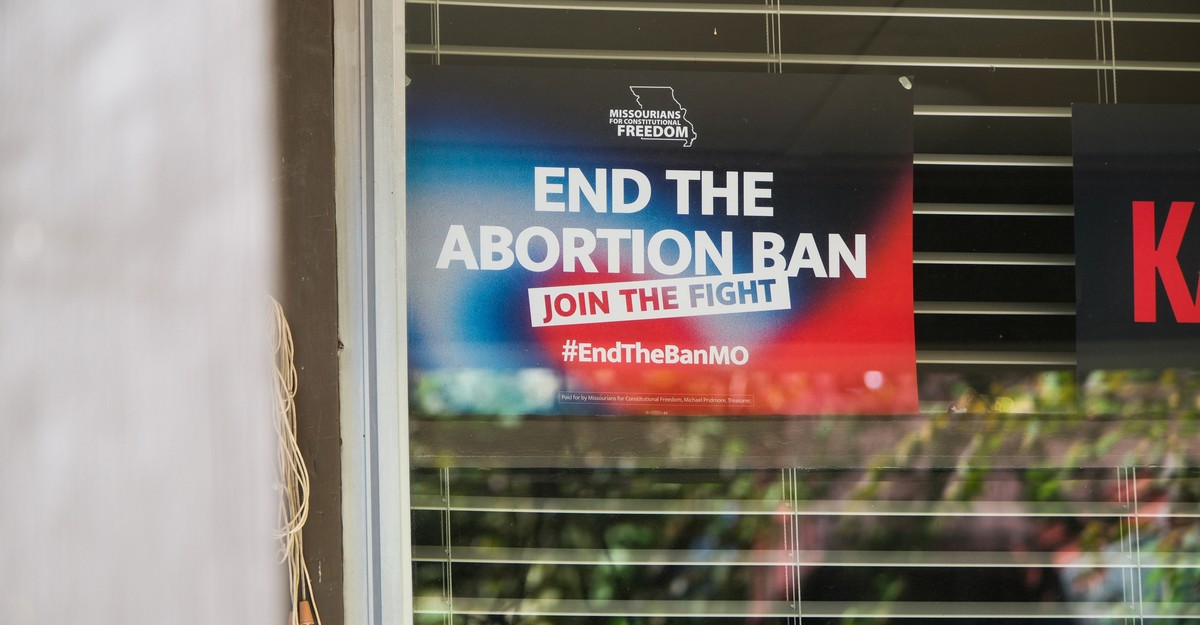Voters seemed willing to back both state referenda enshrining reproductive rights and the candidate whose Supreme Court appointees overturned Roe.
The morning after the election, a second result emerged beside the blindingly obvious one that Donald Trump will once again be president of the United States: In some places, abortion rights remained a winning issue.
Ballot measures to expand abortion access passed in seven states, including Missouri, Arizona, and Montana, three places that Trump won. Previous polling and election outcomes had shown that most Americans support abortion rights. Less clear was how they’d behave with Trump on the ballot. The issue of abortion may have shed its partisan salience—just not in a way that helped Kamala Harris and other Democrats. Abortion access “is becoming less partisan, ironically, in the sense that Republicans and independents are more likely to support abortion rights,” Mary Ziegler, a law professor at UC Davis and an Atlantic contributor, told me, “while not translating that into support for Democratic candidates.”
For Democrats and abortion-rights activists, last night’s referenda were glittering pinpricks of light in an otherwise long, dark night of defeats. The White House—gone; control of the Senate—gone; the House of Representatives—clearly leaning Republican. Missouri, which went for Trump by 18 percent and had one of the strictest abortion bans in America, voted 52 to 48 percent to establish a constitutional guarantee to the “fundamental right to reproductive freedom.” Similar measures passed in Arizona and Montana, by 23 and 15 points so far, respectively. Four other states—Nevada, Maryland, New York, and Colorado—passed their own abortion measures, though these were less politically revealing, given the existing abortion-rights protections there.
Not all the news was rosy for abortion-rights activists. Ballot measures failed in Nebraska by 2.6 points and in South Dakota by 17. Different reasons might account for those losses, Ziegler said. Nebraska had two abortion referenda on the ballot, each proposing contrary changes to state law, which could easily have confused voters. In Florida, a large majority of voters did support an effort to overturn the state’s six-week abortion ban—but it fell a few points short of the 60 percent needed to pass.
Those three state results were the biggest wins the anti-abortion movement has achieved since the Supreme Court’s Dobbs decision overturned Roe v. Wade in 2022. Expect to hear this example touted more widely, Ziegler said. “Activists will take that to Republicans and say, ‘Hey, you don’t need to be afraid of being pro-life. You can take aggressive positions,’” she told me. “This should be a huge encouragement to the pro-life movement,” the conservative political commentator Matt Walsh wrote on X yesterday afternoon. “We have a lot of work to do. But the people are on our side.”
That would be an overstatement, based on last night’s results. Harris had worked to make abortion rights a strong campaign issue—though not enough, evidently, to carry her party to victory. But abortion-rights groups achieved victories in spite of the Democrats’ failed presidential efforts. Several factors are involved: Abortion access is popular. And Trump, through his chaotic and confusing abortion tightrope walk, may have successfully neutralized the issue for now, for his voters: assuring enough pro-choice voters that he would protect their reproductive rights, while hanging on to pro-life base voters who want him to further restrict abortion access. “Trump created this possibility of being all things to all people,” Ziegler told me.
But when you’re president, you have to pick. A near future in which Trump continues to downplay any talk of restricting abortion and focuses instead on issues that do not divide his voter coalition, such as immigration, is easy to imagine. “And then there’s a scenario where he doesn’t, and the partisan divide springs back as ever,” Ziegler said. If that happens, then what the anti-abortion movement will be demanding from a second Trump administration is immediate executive action to restrict abortion. That could mean appointments of committed anti-abortion officials to important Cabinet positions—former Texas solicitor general Jonathan Mitchell for attorney general, say, or Heritage Foundation adviser Roger Severino as the head of the Department of Health and Human Services. It could also involve a reinterpretation of the Comstock Act, which could see abortion banned across the country de facto, without any congressional legislative action at all.
The anti-abortion movement may not be successful in these maneuvers. Little suggests, right now, that Trump is interested in cementing his legacy as the most pro-life president in history. But the one thing Americans can almost certainly count on is a slew of new anti-abortion judges appointed to the federal courts. Conservative groups are already floating favored names—such as the Fifth Circuit’s James Ho and Kristen Waggoner, the chief executive of the pro-life group Alliance Defending Freedom—for the Supreme Court. With a Republican Senate, these could be easy appointments. “That may be how Trump has his cake and eats it too,” Ziegler said. “Put conservatives on the courts, and their decisions may not happen until years after he’s no longer in office.”
After last night, abortion-rights activists can take a measure of comfort in the confirmation that their position is still popular. But cutting against that is the fact that abortion rights are no cure-all for Democrats—especially when the leader of the Republican Party has apparently managed to detoxify the issue.

